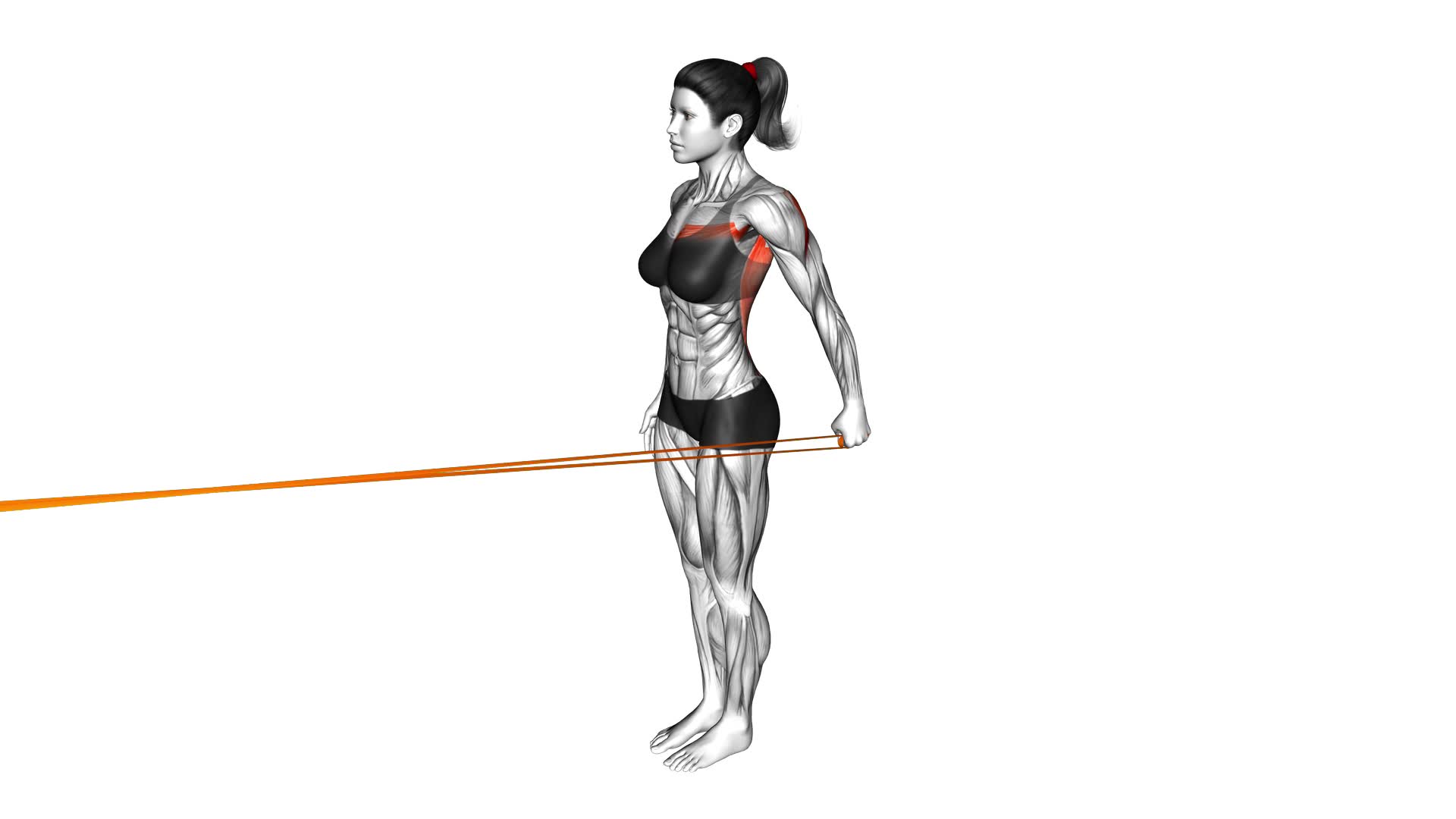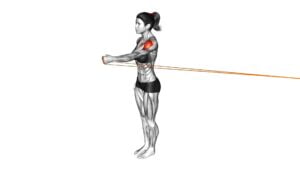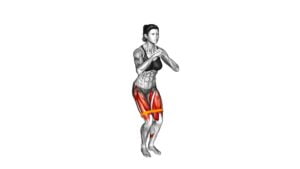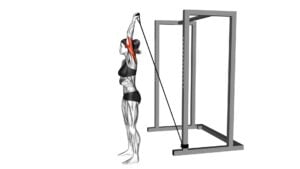Resistance Band Standing Single Arm Lateral Shoulder Extension (female) – Video Exercise Guide & Tips

Are you looking to strengthen and tone your shoulders? If so, the Resistance Band Standing Single Arm Lateral Shoulder Extension is the perfect exercise for you.
Watch This Exercise Video
This video exercise guide provides step-by-step instructions and tips to ensure you perform the exercise correctly.
With variations and progressions to challenge yourself, as well as common mistakes to avoid, you'll be able to incorporate this exercise into your shoulder workout routine and see results in no time.
Get ready to take your shoulder training to the next level!
Key Takeaways
- Targets shoulder muscles
- Improves shoulder mobility
- Increases upper body strength
- Helps prevent injuries
Benefits of the Resistance Band Standing Single Arm Lateral Shoulder Extension
The resistance band standing single arm lateral shoulder extension offers a range of benefits for women looking to strengthen and tone their shoulder muscles. This exercise specifically targets the shoulder muscles, helping to improve shoulder mobility and increase upper body strength. By using a resistance band, you can easily adjust the intensity of the exercise to match your fitness level and goals.
Shoulder mobility is crucial for everyday activities such as reaching, lifting, and carrying objects. By incorporating the resistance band standing single arm lateral shoulder extension into your workout routine, you can improve the range of motion in your shoulders, making these activities easier and more efficient.
Additionally, this exercise also helps to strengthen the entire upper body. As you extend your arm out to the side against the resistance of the band, your shoulder muscles are engaged, along with the muscles in your back and chest. This results in improved overall upper body strength, making everyday tasks and other exercises more manageable.
To ensure you get the most out of this exercise, it's important to maintain proper form and technique. Transitioning into the subsequent section, we'll discuss the proper form and technique for the resistance band standing single arm lateral shoulder extension, so you can maximize the benefits and avoid any potential injury.
Proper Form and Technique for the Exercise
Start by standing with your feet shoulder-width apart and gripping the resistance band in your hand. To ensure proper form and technique for the Resistance Band Standing Single Arm Lateral Shoulder Extension, it's important to pay attention to a few key details.
First, make sure your core is engaged and your spine is neutral. Avoid arching your back or leaning to one side. Keep your shoulder blades pulled back and down, maintaining good posture throughout the movement.
One common mistake is using too much momentum. Remember, this exercise is all about controlled movements, so avoid swinging your arm or using excessive force. Focus on maintaining tension in your shoulder muscles throughout the entire range of motion.
Another mistake to watch out for is letting the resistance band pull your arm too far back. This can strain your shoulder joint and lead to injury. Instead, aim for a comfortable range of motion where you feel a good stretch in your shoulder muscles without any pain.
To incorporate proper form and technique, start by performing the exercise with a lighter resistance band. This will allow you to focus on your form and ensure you're engaging the correct muscles. Gradually increase the resistance as you become more comfortable and confident in your technique.
Now that you have a solid foundation in the proper form and technique for the Resistance Band Standing Single Arm Lateral Shoulder Extension, let's move on to exploring variations and progressions to challenge yourself further.
Variations and Progressions to Challenge Yourself
To challenge yourself further, try incorporating variations and progressions into your Resistance Band Standing Single Arm Lateral Shoulder Extension exercise routine. By adding different equipment options and modifications for beginners, you can keep your workouts interesting and continue to improve your strength and stability.
Here are some ideas to help you take your shoulder extension exercise to the next level:
- Resistance Band Level Up: If you've been using a light resistance band, try switching to a heavier one to increase the challenge. This will engage your muscles even more and help you build strength.
- Single Arm Lateral Raise: Instead of extending your arm straight out to the side, try lifting it diagonally across your body. This will target different muscles and provide a new stimulus for growth.
- Standing on One Leg: Incorporate balance training by standing on one leg while performing the exercise. This will engage your core and challenge your stability, making the exercise more dynamic and effective.
- Resistance Band Pull Apart: After completing the shoulder extension, pull the resistance band apart by bringing your hands towards your chest. This will target your upper back and improve your posture.
Remember to start with modifications for beginners if you're new to this exercise or if you're recovering from an injury. As you become more comfortable and confident, gradually increase the difficulty level to continue challenging yourself and achieving your fitness goals.
Common Mistakes to Avoid During the Exercise
When performing the resistance band standing single arm lateral shoulder extension exercise, there are common mistakes that you should avoid to ensure proper form and maximize the effectiveness of the exercise.
One common mistake is using too heavy of a resistance band. While it may be tempting to challenge yourself with a heavier band, using one that's too difficult can compromise your form and increase the risk of injury. It's important to choose a band that allows you to maintain proper technique throughout the movement.
Another mistake to avoid is allowing your body to sway or twist during the exercise. This can happen when you try to use momentum to complete the movement, rather than relying on your shoulder muscles. To prevent this, engage your core and keep your body stable throughout the exercise.
Improper grip is another common mistake. Make sure to securely hold the resistance band handle, keeping your wrist in a neutral position. Avoid gripping too tightly, as this can lead to unnecessary tension in your forearm and hand.
Lastly, rushing through the exercise is a mistake that many people make. To get the most out of this exercise, focus on the slow and controlled movement. This will ensure that you're targeting the shoulder muscles effectively.
Tips for Incorporating the Exercise Into Your Shoulder Workout
To enhance your shoulder workout, include the resistance band standing single arm lateral shoulder extension exercise as part of your routine. This exercise targets the lateral deltoid muscle, helping to strengthen and tone your shoulders.
Here are some tips to help you incorporate this exercise into your shoulder workout:
- Start with a light resistance band and gradually increase the intensity as you become more comfortable with the movement.
- Maintain proper form throughout the exercise by keeping your core engaged and your back straight.
- Perform the exercise in a slow and controlled manner, focusing on the contraction of your shoulder muscles.
- Incorporate shoulder workout modifications by adjusting the height of the anchor point for the resistance band. Lower anchor points will target the middle deltoid, while higher anchor points will target the rear deltoid.
If you're looking for alternative exercises to add variety to your shoulder workout, consider incorporating exercises such as dumbbell lateral raises, seated military presses, or cable lateral raises. These exercises target different areas of your shoulders and can help you achieve a well-rounded shoulder workout.
Remember to listen to your body, start with lighter weights, and gradually increase the intensity as your strength improves.
Frequently Asked Questions
How Long Should I Hold the Resistance Band During the Exercise?
When doing resistance band exercises, like the one you mentioned, it's important to hold the band for the right amount of time. The duration of the hold can vary depending on your fitness level and goals.
Generally, you should aim to hold the resistance band for about 2-3 seconds at the top of the movement to engage your shoulder muscles effectively.
However, it's always a good idea to consult with a fitness professional to get personalized advice for your specific needs.
Can I Use a Dumbbell Instead of a Resistance Band for This Exercise?
Yes, you can use a dumbbell instead of a resistance band for this exercise.
While resistance bands are great for targeting specific muscles and providing constant resistance throughout the movement, using dumbbells can also be effective.
Dumbbells allow for a greater range of motion and can provide a different type of resistance.
However, keep in mind that resistance bands have their own unique benefits, such as being portable and versatile for various exercises.
How Many Sets and Reps Should I Do for Optimal Results?
To maximize your results, it's important to know how many sets and reps to do for the resistance band standing single arm lateral shoulder extension.
For advanced lifters, try progressing by increasing the resistance or adding more reps.
This exercise is great for targeting your shoulder muscles and can be a valuable addition to your workout routine.
Incorporating it regularly can help improve strength and stability in your shoulders, enhancing overall upper body strength.
Is This Exercise Suitable for Beginners?
Is this exercise suitable for beginners? Yes, it is.
To perform the Resistance Band Standing Single Arm Lateral Shoulder Extension, you'll need a resistance band. Using a resistance band is necessary for this exercise as it adds resistance to your shoulder muscles.
For beginners, it's recommended to start with a lighter resistance band and gradually increase the resistance as you get stronger.
This exercise helps strengthen your shoulder muscles and improve overall upper body strength.
Can I Perform This Exercise Seated Instead of Standing?
Yes, you can definitely perform this exercise seated instead of standing.
The seated variation of the Resistance Band Standing Single Arm Lateral Shoulder Extension is a great option if you prefer or need to sit during your workouts.
It can also be a modification for individuals with shoulder injuries who may find it more comfortable and manageable.
This modification allows you to still target and strengthen your shoulder muscles effectively while seated.
Conclusion
Incorporating the resistance band standing single arm lateral shoulder extension into your workout routine can provide numerous benefits for your shoulders.
This exercise helps to strengthen and tone the muscles in your shoulders, improving your overall upper body strength and stability.
By following proper form and technique, and challenging yourself with variations and progressions, you can maximize the effectiveness of this exercise.
Avoid common mistakes and remember to always listen to your body.
Add this exercise to your shoulder workout for a well-rounded and powerful upper body.

Author
Years ago, the spark of my life’s passion ignited in my mind the moment I stepped into the local gym for the first time. The inaugural bead of perspiration, the initial endeavor, the very first surge of endorphins, and a sense of pride that washed over me post-workout marked the beginning of my deep-seated interest in strength sports, fitness, and sports nutrition. This very curiosity blossomed rapidly into a profound fascination, propelling me to earn a Master’s degree in Physical Education from the Academy of Physical Education in Krakow, followed by a Sports Manager diploma from the Jagiellonian University. My journey of growth led me to gain more specialized qualifications, such as being a certified personal trainer with a focus on sports dietetics, a lifeguard, and an instructor for wellness and corrective gymnastics. Theoretical knowledge paired seamlessly with practical experience, reinforcing my belief that the transformation of individuals under my guidance was also a reflection of my personal growth. This belief holds true even today. Each day, I strive to push the boundaries and explore new realms. These realms gently elevate me to greater heights. The unique combination of passion for my field and the continuous quest for growth fuels my drive to break new ground.







